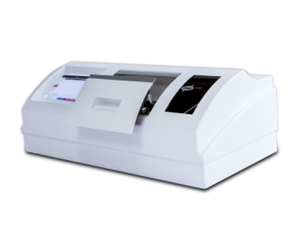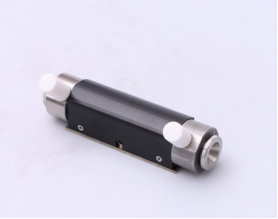May 07, 2025
Tag:
I. Preface
With the increase of social pressure, depression has become a mental illness that seriously affects human physical and mental health worldwide. According to data from the World Health Organization (WHO), over 350 million people worldwide suffer from depression. In the past decade, the growth rate of patients has been approximately 18%. It is predicted that by 2030, the number of patients may exceed the total number of all cardiovascular disease patients combined. The development of new antidepressant drugs is extremely urgent, and during the drug development process, the precise determination of the optical rotation characteristics of the drugs is of vital importance. The fully automatic polarimeter Digipol-P610 of Shanghai Jiahang Instrument & Meter Co., LTD., with its advanced technology and excellent performance, can provide key support for the research and development of new antidepressant drugs.
2. Background of the Research and Development of New Antidepressant Drugs
The antidepressant drugs currently available on the market, such as traditional medications represented by SSRI and SNRI, have a lag in clinical effects (usually taking more than 2 to 4 weeks to take effect). Some patients have limitations such as long-term medication without relief, multiple side effects (including gastrointestinal symptoms, addiction, mania, sexual dysfunction, etc.), and poor efficacy (54% of patients cannot be completely relieved after taking the medicine and need to enter second-line treatment). The development of antidepressant drugs with a brand-new mechanism of action, rapid onset and few side effects has become an important goal in the medical field. Many new antidepressants are chiral drugs, and chiral drugs of different configurations may have significant differences in terms of biological activity, pharmacological effects and toxic and side effects. Accurate determination of the optical rotation characteristics of these drugs is of great significance for screening drug configurations with the best activity and safety, in-depth study of the relationship between drug molecular structure and activity, and optimization of drug synthesis processes.
3. Introduction to Digipol-P610 Fully Automatic Digital Polarimeter
(1) Technical Principles
The Digipol-P610 fully automatic digital polarimeter adopts the advanced photoelectric detection automatic balance principle, and is equipped with a stable optical system and precise detection components. When polarized light passes through a drug sample solution with optical rotation, the vibration direction of the polarized light will rotate. The instrument can quickly and accurately detect this rotation Angle, that is, the optical rotation, and convert it into a digital signal for display and processing.
(II) Functional Features
Multi-wavelength detection function: During the development of new antidepressant drugs, it may be necessary to detect weak optical rotation under a non-589nm standard sodium light source. Digipol-P610 can meet the optical rotation detection requirements of different drugs at specific wavelengths, providing researchers with more comprehensive optical rotation data and contributing to an in-depth understanding of the characteristics of drug molecules in different light environments.
Advantages of the digital platform: Operating on a digital platform, this instrument ensures measurement accuracy, repeatability and reliability. Meanwhile, it can significantly improve the response speed of the test samples, achieve high-speed measurement, and effectively shorten the sample measurement time. During the drug research and development stage, it is necessary to conduct optical rotation detection on a large number of drug samples with different configurations. The rapid measurement speed can greatly improve the research and development efficiency.
Complies with industry standards: Fully meets the relevant requirements of the National Pharmacopoeia, GMP, GLP, etc., and is equipped with functions such as user hierarchical management, electronic signature, password management, network transmission, data protection and traceability. With an extremely large database, data can be saved, transmitted, printed and traced. Users can also define and pre-store common measurement methods by themselves. These functions ensure the accuracy, traceability and standardization of experimental data during the drug research and development process, meeting strict industry regulatory requirements.
Built-in Peltier temperature control: During the drug development process, temperature may affect the optical activity of the drug. The Digipol-P610 is equipped with a built-in Peltier temperature control system, which can enhance the stability of the instrument, ensure accurate measurement of the optical rotation of drug samples under different environmental conditions, effectively eliminate temperature interference, and guarantee the accuracy of the measurement results.
LED cold light source: The use of LED cold light source to replace traditional sodium lamps and halogen tungsten lamps has the advantages of long service life, high stability and low energy consumption. It reduces the frequency and cost of light source replacement, while enhancing the stability and measurement accuracy of the instrument, providing a reliable light source guarantee for long-term drug research and development experiments.
4. Application Scenarios
(1) Screening of chiral drug configurations
In the research and development of new antidepressant drugs, synthetic chiral drugs usually have multiple configurations. Studies have shown that chiral drugs of different configurations may have significant differences in the efficacy of treating depression. For example, two enantiomers of a certain new type of antidepressant drug, one may have significant antidepressant activity, while the other may not only have low activity but also have serious side effects. The precise determination of parameters such as specific rotation of drugs with different configurations using the Digipol-P610 fully automatic polarimeter can help researchers quickly screen out the drug configuration with the best antidepressant activity and point out the direction for subsequent drug research and development work.
(2) Research on the Relationship between Drug Molecular Structure and Activity
The optical rotation characteristics of drugs are closely related to their molecular structure. The optical rotation changes of new antidepressant drugs with different structural modifications were measured by Digipol-P610, and combined with the biological activity data of the drugs, the relationship between the molecular structure and activity of the drugs can be deeply explored. For instance, when a certain functional group in a drug molecule is modified, a specific change in optical rotation is detected through polarimeter measurement, and at the same time, biological activity tests indicate that the antidepressant activity of the drug also increases or decreases accordingly. This kind of correlation study is conducive to optimizing the design of drug molecules and developing more effective antidepressants.
(3) Optimization of drug synthesis processes
During the synthesis process of new antidepressant drugs, minor changes in reaction conditions may lead to alterations in the optical activity of the products. Real-time monitoring of the optical rotation of the products during the reaction process using Digipol-P610 can promptly detect the deviation of the reaction. For example, in the synthesis reaction of a certain new type of antidepressant drug, when the reaction temperature or reaction time changed, the optical rotation of the product was detected by a polarimeter to deviate from the expected value. Based on this feedback, researchers can promptly adjust the reaction parameters, optimize the synthesis process, enhance the purity and yield of the target product, and ensure that the synthesized drug has stable and compliant optical rotation properties.
5. Application Cases
(1) Case Background
A certain pharmaceutical company is committed to developing new antidepressant drugs. During the early stage of drug synthesis, it obtained a variety of chiral drug samples with different configurations. In order to screen out the drug configuration with the best antidepressant activity and deeply study the relationship between the drug molecular structure and activity, it is necessary to precisely determine the optical rotation characteristics of these samples.
Implementation of the experimental plan
Jiahang,


Jiahang Instruments and supporting equipment: Use the Digipol-P610 fully automatic digital polarimeter from Shanghai Jiahang; It is equipped with a high-precision 100mm temperature-controlled test tube (compatible with Digipol-P610) for precisely controlling the test temperature of the sample; A precision balance with an accuracy of one ten-thousandth is used for accurately weighing the mass of samples. 100mL volumetric flask, used for preparing sample solutions of accurate concentration.
Sample preparation: Purify the various new antidepressant drugs with different configurations synthesized to ensure that the purity of the samples meets the experimental requirements.
Experimental steps:
Accurately weigh a certain mass of the sample with a precision balance, place it in a 100mL volumetric flask, add an appropriate amount of solvent, stir thoroughly to ensure complete dissolution, then add water to make up to the mark, shake well, and obtain a sample solution of accurate concentration.
Turn on the Digipol-P610 fully automatic polarimeter, select the appropriate light source wavelength according to the characteristics of the sample, preheat the instrument for 5 to 10 minutes to bring the instrument to a stable working state.
Change the instrument test mode to the specific rotation mode, set the concentration to the concentration of the prepared sample, and set the test tube length to 100mm.
Inject an appropriate amount of sample solution into a 100mm temperature-controlled test tube that has been cleaned and dried, ensuring no bubbles are produced, and then close the test tube stopper. Place the test tube with added samples into the sample chamber of the polarimeter, insert the temperature probe into the constant temperature test tube, set the instrument control temperature to 25℃, turn on the temperature control button and start the temperature control.
After the temperature stabilizes, press the measurement button. The instrument will automatically measure and display the optical rotation data of the sample. Repeat the measurement multiple times and take the average as the final measurement result.
(III) Experimental Results and Significance
By measuring the optical rotation of drug samples with different configurations, researchers found that one of the configurations of the drug had unique optical rotation characteristics and demonstrated the strongest antidepressant activity in subsequent biological activity tests. This result provides important experimental evidence for the pharmaceutical company's research and development of new antidepressant drugs, determines the direction of further optimization and development of drug configuration, accelerates the drug research and development process, and is expected to bring more effective treatment drugs to a large number of patients with depression.
6. Supporting Equipment and Operating Procedures
(1) Supporting equipment
High-precision 100mm temperature-controlled test tube: Used in conjunction with the Digipol-P610 fully automatic polarimeter, it can precisely control the sample testing temperature within the range of ±0.1℃. Through the built-in temperature control device, the influence of temperature on the optical activity of the sample can be effectively reduced, ensuring that optical activity detection is carried out at the specified temperature and improving the accuracy and reliability of the test results. Before use, it is necessary to check whether the sealing property of the temperature-controlled test tube and the temperature control function are normal.
High-precision electronic balance (with an accuracy of one ten-thousandth) : It is used for accurately weighing the mass of samples, and its accuracy can reach ±0.0001g. When weighing samples, the balance should be placed on a stable and vibration-free workbench. Calibration should be carried out before use to ensure the accuracy of the weighing results. When weighing samples, be careful to avoid spillage and moisture absorption of the samples to ensure the accuracy of the sample quality.
100mL volumetric flask: It is used for accurately preparing sample solutions, and its precision meets the experimental requirements. During the process of preparing the solution, the weighed sample should be completely dissolved and then transferred to a volumetric flask. Water should be added to make up to the mark. When making up the volume, make sure your line of sight is level with the scale line to ensure the accuracy of the solution concentration. After use, the volumetric flask should be cleaned in time and dried for future use.
(II) Operating Procedures
Instrument preheating: Turn on the power switch of the Digipol-P610 fully automatic polarimeter, and select the appropriate light source wavelength according to the test requirements. For example, for some new antidepressant drugs, specific non-standard wavelengths may need to be selected. Preheat the instrument for 5 to 10 minutes to ensure that the optical system and detection components of the instrument reach a stable working state, guaranteeing the accuracy of the measurement results. During the preheating process, you can check whether the display screen and indicator lights of the instrument are working properly.
Parameter Settings: Set the instrument's testing mode to the specific rotation mode, set the concentration parameter according to the actual concentration of the prepared sample solution, and set the test tube length parameter according to the length of the test tube used. Accurately setting parameters is a key step to ensure that the measurement results accurately reflect the optical rotation characteristics of the sample. After the setting is completed, it is necessary to carefully check whether the parameters are correct.
Sample preparation: Accurately weigh a certain mass of the sample with a high-precision electronic balance, place it in a clean beaker, add an appropriate amount of solvent, and stir until it is completely dissolved. Transfer the dissolved sample solution to a volumetric flask, rinse the beaker with a small amount of solvent several times, and transfer the rinsing solution to the volumetric flask at the same time. Then add water to make up to the mark on the volumetric flask, shake well and set aside for later use. During the sample preparation process, it is necessary to pay attention to the operation norms to avoid introducing impurities and errors.
Test: Inject an appropriate amount of sample solution into a 100mm temperature-controlled test tube that has been cleaned and dried, ensuring no bubbles are produced, and then close the test tube stopper. Place the test tube with added samples into the sample chamber of the polarimeter, insert the temperature probe into the constant temperature test tube, set the instrument control temperature to the specified value (such as 25℃), turn on the temperature control button, and start the temperature control. After the temperature stabilizes, press the measurement button. The instrument will automatically measure and display the optical rotation data of the sample. During the testing process, make sure the test tubes are placed correctly to avoid vibration and interference from external light.
Data recording and processing: Record the optical rotation data displayed by the instrument, and calculate parameters such as the specific rotation of the sample according to the formula. Conduct statistical analysis on the data from multiple measurements, calculate the average value, standard deviation, etc., and evaluate the accuracy and repeatability of the data. Accurate recording and scientific processing of data can effectively evaluate the optical rotation characteristics of samples and the reliability of measurement results, providing strong data support for drug research and development.
Instrument cleaning and maintenance: After the test is completed, remove the test tube, rinse it thoroughly with clean water and let it dry. Turn off the power of the polarimeter and clean the instrument regularly, including wiping the surface of the instrument and cleaning the sample chamber, etc. In accordance with the requirements of the instrument's user manual, regularly calibrate and maintain the instrument, such as checking the performance of the optical system and replacing vulnerable parts, to ensure that the instrument is always in good working condition and extend its service life.
7. Summary and Outlook
The Digipol-P610 fully automatic polarimeter of Shanghai Jiahang Instrument & Meter Co., Ltd. has important application value in the research and development of new antidepressant drugs. By precisely determining the optical rotation characteristics of drugs, it can help researchers screen out the drug configuration with the best antidepressant activity, deeply explore the relationship between the molecular structure and activity of drugs, optimize the drug synthesis process, and accelerate the drug research and development process. With the continuous development of medical technology, the demand for the research and development of new antidepressant drugs will continue to increase. The Digipol-P610 fully automatic polarimeter will also be constantly upgraded and innovated, providing more powerful and precise technical support for scientific research in the medical field and contributing to solving the global problem of depression.


Contact Us
Tel: (+86) 400 610 1188
WhatsApp/Telegram/Wechat: +86 13621645194
+86 15021993094
Follow Us:




 Pharma Sources Insight January 2025
Pharma Sources Insight January 2025


